In order to better understand and help resolve product issues quickly, the GM Warranty Parts Center (WPC) occasionally requests the return of specific parts replaced at dealerships through the Global Warranty Management (GWM) system. Returned parts are analyzed by Brand Quality, Engineering, Suppliers, Production Plant, Assembly Plant and Quality Management personnel to help identify the issue, determine the root cause, and implement a correction.
When returning parts to the WPC, dealerships must include the proper documentation for the repair as well as follow the preparation, shipping and packaging guidelines regarding the type of part being shipped (non-hazardous vs. hazmat/dangerous goods). (Fig. 1)
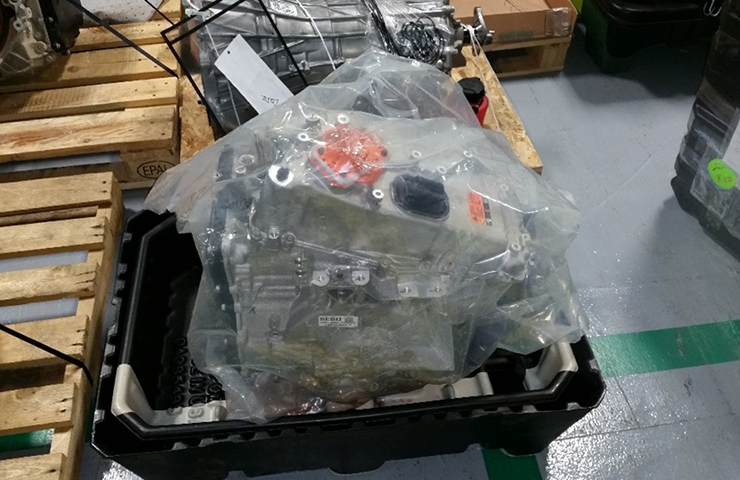 Fig. 1
Fig. 1
Identify Hazardous Materials
Some common automotive hazardous material examples include items such as air bags, seat belt pretensioners, brake boosters, compressed gas shocks and lifts, batteries (including lithium ion and lithium metal batteries), paint, adhesives, solvents, hazardous waste, and any part that comes in contact with flammable liquid (i.e., fuel).
For example, if a fuel line received from the parts warehouse is considered new and unused, it is not considered a hazmat material. However, if the same part has been installed in a vehicle and has been in contact with fuel, it is now considered a hazardous material and should be shipped under the 49 CFR Hazardous Material Regulations and shipped accordingly.
TIP: Do not ship high-voltage lithium ion batteries to the WPC. The GM Battery Service Center provides return instructions with each lithium ion battery section shipment. Refer to Bulletin #18-NA-236 for return instructions. If a special parts return request comes from the WPC, follow the instructions for where to return the battery provided at the time of the request.
When printing out the GWM parts request transaction label (Fig. 2), the label might indicate that it is not hazardous, which is based on a new or unused part. Any part that comes in contact with flammable liquid (i.e., fuel) is considered a hazardous material.
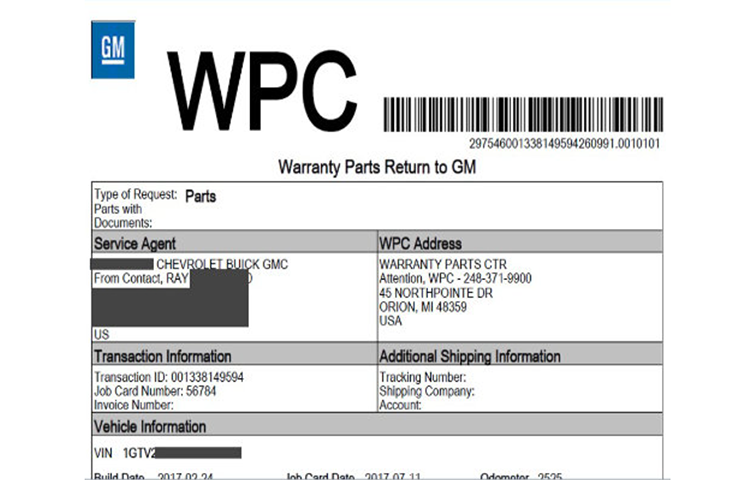 Fig. 2
Fig. 2
Shipping Non-Hazmat/Non-Dangerous Goods
When shipping non-hazardous/non-dangerous goods to the WPC:
- Properly protect and package all returned parts in original CCA packaging so they are not damaged when received at the WPC. All parts should be returned to the WPC in original packaging. For example, with an engine assembly, the pallet and cardboard box are both necessary. The dealership will be debited (depending on the safety situation) for failure to return in a crate/box/container. Only use boxes without hazardous material marking and labeling to return non-hazardous material parts. Incorrect use of these boxes can cause delay in receiving at the WPC, and may result in the transaction being debited.
- Parts containing or soaked by fluids, such as oil, must be thoroughly drained, wiped clean and placed in an appropriate packing container. Securely package the parts to prevent leakage or contamination. Transfer all caps and plugs from the new part to the replaced part before shipping. If parts are received at the WPC with fluids such as oil or fuel, the part will not be accepted as “Received” and the transaction will be debited.
- If the requested core parts are not returned to the WPC, the transaction will be debited.
Examples of Parts Returned Improperly
Parts that are not shipped in the correct CCA packaging, properly secured, or drained of fluids can result in damaged or lost parts, which can be subject to a transaction debit.
For example, a soaked box shows that the parts were not thoroughly drained and placed in an appropriate packing container. (Fig 3)
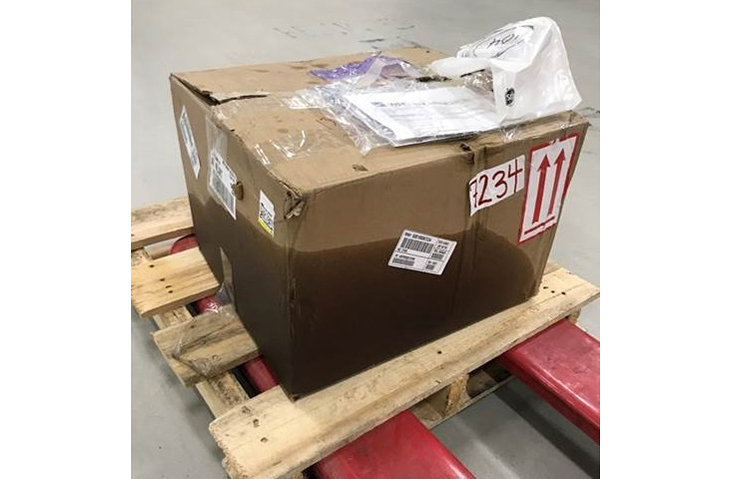 Fig. 3
Fig. 3
Parts also must be securely packaged to prevent leakage or contamination. (Fig. 4)
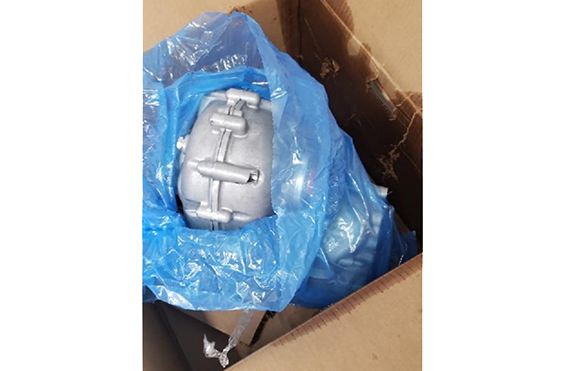 Fig. 4
Fig. 4
Parts received at the WPC with fluids are not accepted as “Received” and the transaction will be debited. (Fig 5)
 Fig. 5
Fig. 5
Using the incorrect packaging also can result in damaged or missing parts. Heavy or large parts placed in the wrong packaging may move around during shipping and eventually break through the box. (Fig. 6)
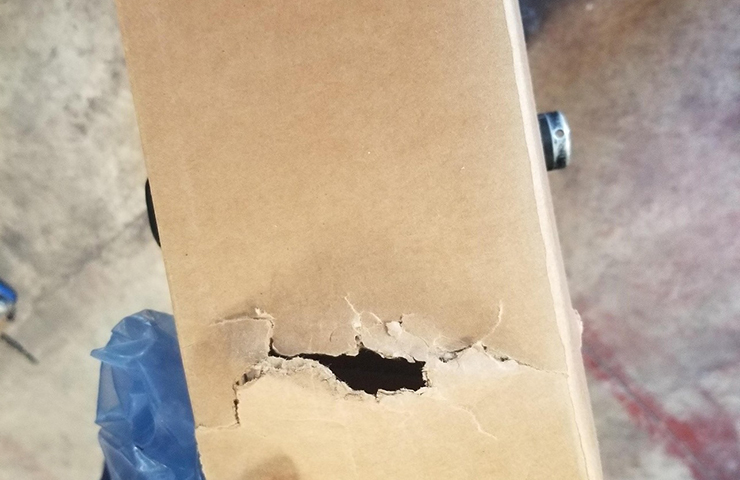 Fig. 6
Fig. 6
In addition, smaller parts may be damaged or bent if they are returned in packaging that is too large or too small. (Fig. 7)
 Fig. 7
Fig. 7
To prevent damage when returning parts, whenever possible, use CCA packaging, secure the parts in the container and apply proper taping to the package.
Guidelines for Returning Parts
To prepare non-hazardous/non-dangerous goods for return to the WPC:
- Use a paint pen to clearly mark or circle the area of concern on the part, such as a leak, crack, premature wear or defect, in order for the area of defect to be easily identified.
- Ensure that the request being made is for the actual failed part; do not send a similar or new part.
- Do not remove any pieces from the part being sent back.
- When identifying parts, be sure to do so in an area that will not damage the part being sent back. For example: Do not wrap a label or metal tag wire around wiper blade inserts, do not apply tape around door seals, and do not stick moldings together.
- Return all parts together that are related to the repair procedure covered by the labor operation on the part return request. For example, a transaction for labor operation T5603, replace 8 injectors, should have all 8 injectors returned under one part return request.
- Bundle together and ship all parts related to the specific labor operation being requested.
- Do not send multiple requests in the same box. Ship each individual request in a separate box with its unique GWM shipping label affixed on the top of the box and on one outward-facing side.
- Inside the package, include the GWM Parts Return shipping label, job card with technician comments, and other related documentation to allow parts to be successfully routed and analyzed.
- Highlight the Transaction Number and place the folded documentation in the plastic packing bag with the highlighted Transaction Number facing outward. This process will assist the WPC in handling and crediting the dealership for returning the part in a timely manner. The bag containing all documentation must be securely attached to the appropriate part. Plastic packing bags are available for the protection of the documentation to be included with the parts, consisting of legible copies or hard copy of the job card and the WPC request/shipping label).
- Whenever possible, the container from the new/replacement part should be used for the return of the failed part. All previous labeling on the box should be removed or covered prior to re-use. Leaving a prior shipping label exposed can cause errors in shipping.
- Use only clean, dry boxes to return parts – boxes that have absorbed oil or other fluids should not be used to return parts to the WPC. Be sure to package parts to avoid damage during shipping by using bubble wrap or other protective packing materials. Avoid using any absorbing material that may contaminate the part, such as loose clay absorbent products. Parts must not be shipped loose. It is important that parts arrive at the WPC in the same condition that they were in when removed from the vehicle.
Shipping Engines
Engines that have been run or “hot tested” (i.e., had fuel in them) are considered hazardous material or dangerous goods. Before shipping an engine:
- Drain all fluids and transfer all shipping plugs from the service engine to the returning engine, or cover open cavities with tape.
- Lower the engine into a plastic bag to ensure capture of any residual fluid leakage, place a drainage mat at the base of the original service engine shipping container (box or pod), and place the bagged engine into the original service engine shipping container.
- Bolt and strap the engine to the supporting pallet and cover with the appropriate lid.
- Attach all corresponding documentation before shipping.
Engines returned exactly in this manner do not require any additional or special hazardous material packaging or labels (U.S. only).
Shipping Hazardous Materials
When shipping hazardous materials to the WPC:
- Ship hazardous materials to the WPC using Central Transport. Hazardous materials should never be sent by air transportation.
- When opening a box intended to be reused, carefully cut the tape only, being careful not to cut or rip the cardboard. Be sure all required hazardous material markings and labels are used. If the box is damaged and can’t be reused, the dealership will need to acquire proper packaging.
- Safety devices require UN specification packaging. When packaging a UN specification box for shipment, refer to the closure instructions on the box to properly close and seal the box as tested.
- Do not cover or obscure hazard class labels, markings or other required handling labels with shipping labels or pouches.
- Be sure all other non-needed labels are covered or removed.
- If returning a lead acid battery, all necessary packing materials will be shipped from the WPC. Non-spillable lead acid batteries are considered non-hazardous for purposes of transportation and can be returned to the WPC through regular shipping procedures. At the present time, this is the only battery that can be returned as a non-hazardous part for shipping purposes.
Repair Order Details
Repair order, or job card, information is critical to analyzing product issues. The more detail that is included, the better the results.
Documentation should include detailed information about the customer concern as well as all technician comments regarding the root cause of failure with document ID numbers, test results, diagnostic trouble codes, TAC case number, assembly serial numbers, measurements, and other data. In addition, details should be provided on any characteristics or symptoms of the fault along with operating conditions that were observed when the fault occurred, such as: scan tool data snapshot information, weather, temperature and altitude.
Also attach a scan tool data printout/snapshot, diagnostic worksheets and all substantiating service documents with the job card that is returned with the part. Be sure to include TAC and/or PQC case numbers. Documentation regarding GM representative involvement should be included as well.
Analyzing Product Issues
Brand Quality Managers and Engineering inspect the returned components for quality issues. After inspection, if the parts were found to be defective, they will be scrapped or, if they have a core, sent to the Core Center. A dealership feedback and debit will be issued if:
- The part/component was not defective:
- Not all parts or documents (Cost Comparison for any assembly replacement from dealers required to contact the PQC, completed shop copy of job cards, diagnostic information, etc.) were returned.
- The job card did not contain the Complaint, Cause, and Correction information as required to substantiate the repair. Vague comments such as, “broken”, or “customer satisfaction”, are not acceptable.
- The shop copy of the job card did not contain all proper documentation.
For additional information, refer to the latest version of Bulletin #99-00-89-019.
– Thanks to Scott Lewiston


















